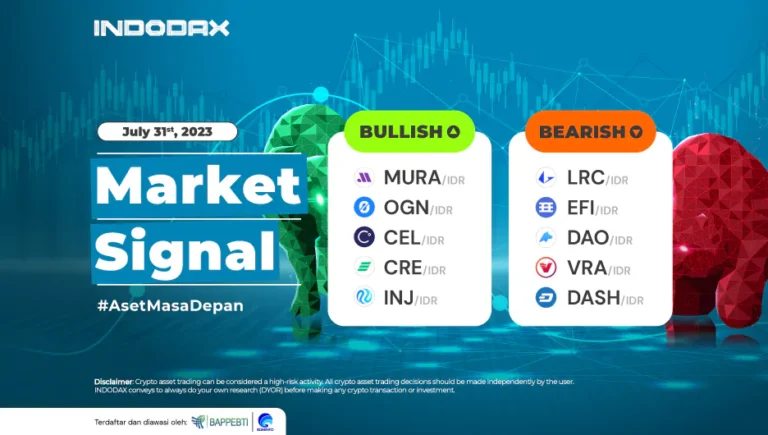Of course, it is essential for potential investors to know what ROI or Return on Investment is.
This one term is a way to measure the performance of the investments made.
This is because Return on Investment will be used to measure and compare the profitability of several investments.
So, to understand more about what is meant by ROI and how to calculate it in the concept of crypto assets, see the following review!
What is ROI?

Return On Investment, abbreviated as ROI, is a financial metric used to evaluate the profit or profit from an investment by comparing the amount of return (profit or loss) generated by the Investment with the investment cost.
Therefore, this way of calculating ROI will be very useful in determining the rate of return on investments made.
Meanwhile, in the concept of crypto asset trading, Return On Investment, which is also interpreted as “return on investment,” can be used as a benchmark for performance used in crypto asset trading.
In this case, Return On Investment helps assess the efficiency level of various crypto assets in investing.
In addition, Return On Investment can also be used to gain efficiency from the types of crypto assets in an investor’s investment portfolio.
Furthermore, Return On Investment or ROI will provide an overview of investment profitability and what investment performance is like compared to the initial Investment.
ROI is usually a proportion and can be considered positive when the Investment generates profits.
Conversely, Return On Investment will be viewed negatively if it shows that the Investment is making a loss.
What Factors Affect ROI?
Meanwhile, several factors that can affect ROI or Return On Investment, according to Wasis (2000:71), are as follows:
- Sales volume.
- Efficient use of capital and costs.
- Profit margins.
- Capital structure.
ROI Advantages and Divantages
So, what are the advantages and disadvantages of ROI? The following are the points, namely as follows:
1. Advantages ROI
- Return On Investment will help investors and financial professionals quickly check investment prospects, saving time and money.
- Return On Investment will also help investigate and measure the potential returns from several investment opportunities.ROI will help to understand and measure the benefits of investing in certain areas.
- Knowing ROI can be used to measure competition around the market.
- One of the essential uses for investment decisions, namely that ROI, is relatively simple but very effective.
- Calculation of ROI in financial ratios is a very simple form of calculation.
- Return On Investment can also be understood even by ordinary people and is universally accepted as a financial concept as well as Investment and business.
- Among its greatest benefits, ROI is relatively uncomplicated and easy to calculate.
2. Disadvantages of ROI
- There needs to be a calculation regarding the Investment holding period on Return On Investment, which can create problems when comparing investment alternatives.
- Return On Investment also does not adjust to risk. It is commonly known that investment returns are directly correlated with risk. The higher the potential return, the greater the probability.
- Return On Investment figures can be exaggerated if the calculation does not include all expected costs. It can happen, be it a crime or not.
- As with other profitability metrics, Return On Investment only emphasizes large financial returns when considering Return on Investment. Here, it is known that ROI does not consider co-benefits, for example, social or environmental goods.
How to Calculate ROI?

The first thing that is important for investors/traders to do before trading/investing is to calculate ROI.
For those of you who are just entering the world of crypto trading, for example, ROI can help you to practice becoming a more qualified trader.
That’s because later, you already know the steps that can be taken according to the results of the ROI calculation.
As mentioned earlier, ROI is usually expressed as a proportion.
The ROI calculation is done by dividing the net profit/loss of Investment by the initial costs/expenses.
However, elapsed holding time or periods are not considered in ROI.
Because of this, investors may pass up the opportunity cost to invest elsewhere.
Calculating ROI can be done by withdrawing the initial value of the Investment’s final value (return net), dividing that new number (net return) by the Investment’s cost, and multiplying that by 100.
If written in the form of a formula, the following is the calculation model:
ROI = (Investment value – initial investment cost): initial investment cost x 100
There are several different ways to calculate ROI, which are as follows:
- ROI = gross profit – expenses/amount invested x 100
- ROI = (profit on Investment – the cost of Investment) / cost of Investment x 100
- ROI = (revenue – the cost of goods sold) / cost of goods sold x 100
ROI Disclaimer
Below are some disclaimer points regarding ROI, which can include things like:
- There is no guarantee of a definite profit from the Investment. Investments have different risks and potential returns depending on market conditions, industry, and other factors.
- The ROI results may vary depending on the calculation method and data source. Therefore, it is important to consider other factors and use valid data sources.
- Make sure to do sufficient research and analysis before making an investment decision. Consult a financial expert if needed.
- In certain circumstances, ROI may not be the most relevant or accurate metric for measuring investment effectiveness.
- So consider using other metrics such as net present value (NPV) or internal rate of return (IRR) if needed.
Conclusion:
Return On Investment (ROI) is a financial metric used to evaluate an investment’s returns and profits.
The trick is to compare the amount of return (profit or loss) generated by the Investment with the cost of the Investment.
Meanwhile, several factors can affect ROI (Return On Investment): sales volume, cost efficiency, profit margin, and capital structure.
So, that was a complete explanation of ROI that you need to understand!
If you want to start investing in Bitcoin, let’s see how to invest in Bitcoin that is safe and legal for beginners.
This article can add to your insights!








